How to look for records of... Foreign Office and Foreign and Commonwealth Office correspondence 1920 onwards
How can I view the records covered in this guide?
How many are online?
- Some
1. Why use this guide?
Use this guide for advice on how to search for specific items of Foreign Office and Foreign and Commonwealth Office correspondence from 1920 onwards. The Foreign Office became the Foreign and Commonwealth Office in 1967. For advice on other types of Foreign Office records see our broader overview guide.
Foreign Office correspondence is a rich source of information on the history of British relations with foreign states and can also provide insights into past domestic issues in foreign countries.
There are tens of thousands of records of general correspondence at The National Archives, ranging from letters, both personal and official, telegrams and despatches, to reports, notes and memos and anything else that was sent from one place or person to another in the business of the Foreign Office.
You can do most searches online but you will usually need to visit us to view the correspondence itself.
2. Online and published records
A small proportion of Foreign Office and Foreign and Commonwealth Office correspondence has been reproduced in published volumes and online (see Further reading). This may provide an easier method of accessing the records than consulting the original documents and will allow you to bypass the search steps explained in this guide.
3. The Foreign Office Index
Correspondence received by the Foreign Office was numbered and categorised. Each category now has a corresponding National Archives record series.
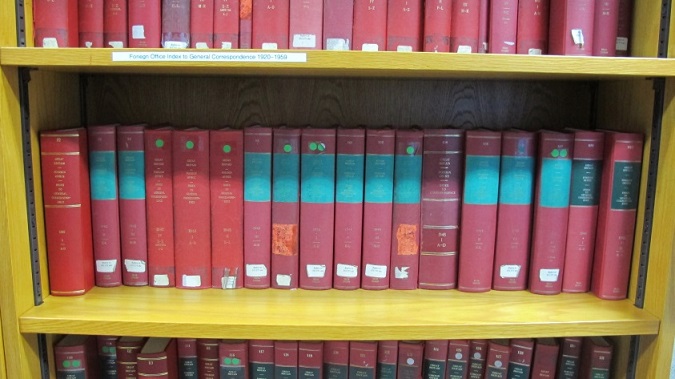
A section of the Foreign Office index for correspondence 1920-1953 and 1959
To identify records by subject or author within these categories from 1920 to 1953 and 1959, you need to use the Foreign Office index (FO 409). This 150-volume index (shown on the right) is available in the Open Reading Room at our building in Kew and can also be downloaded and viewed online for free.
The index was created and used by the staff of the Foreign Office itself but not all the correspondence to which it refers was sent for preservation at The National Archives. Some index entries, therefore, refer to documents that have not been kept. If a document has not been preserved in Foreign Office correspondence, it may survive in the form of confidential prints – our broader guide to Foreign Office records explains more.
From 1954-1958 and from 1960 onwards The National Archives does not have any registers or indexes. Read section 5 of this guide for advice on how to find correspondence from these years.
4. Finding correspondence from 1920-1953 and 1959
To find correspondence from 1920 to 1953 and 1959, you need to use the Foreign Office index (FO 409).
4.1 How to use the Foreign Office index to find correspondence
Step 1: Identify an index entry of interest
Start by looking for the relevant section of the FO 409 index. It is arranged by year, and then alphabetically.
You will need to decide on a keyword and begin your search with the first letter of your keyword. You may have to do some lateral thinking to find your way around the terms used in the subject index. It is not always obvious how the Foreign Office would have originally categorised the subjects.
To search for correspondence relating to the Berlin Airlift in 1948, for example, your search in the online version of FO 409 could begin as follows:
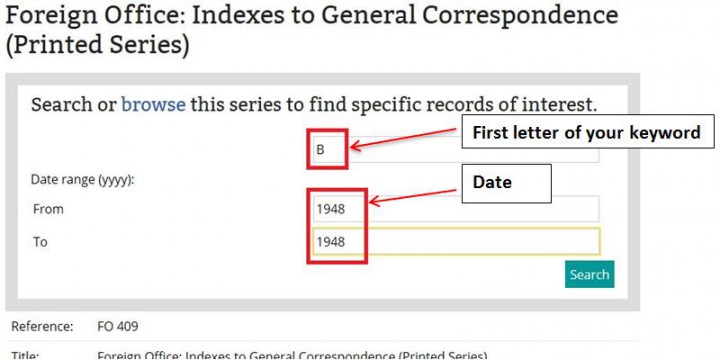
A search in series FO 409, the Foreign Office index, on The National Archives catalogue
Step 2: Note the country code, file number and paper number from the index
A typical index entry looks like this:
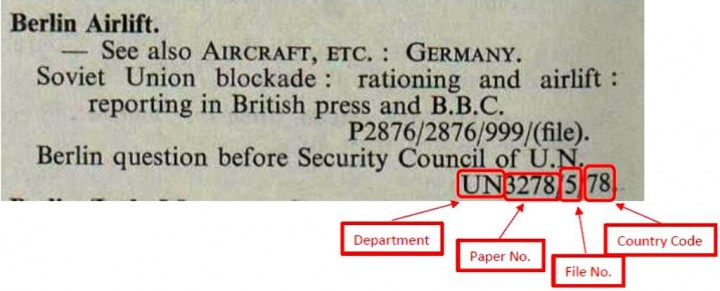
Reading the reference from right to left, the first number is the country code (see section 4.2 for advice on country codes with more than two digits), the second number is the file number and any other number will be a paper number, as shown above. The department code is not needed for an online search but it can sometimes prove useful to know – and is vital when searching using the paper version of the catalogue.
Step 3: Convert the Foreign Office references to National Archives references
Use the advanced search in our catalogue to search using the country code prefixed by the word ‘code’, all in speech marks, and refine your search to FO (Foreign Office records) and the relevant year, like this:
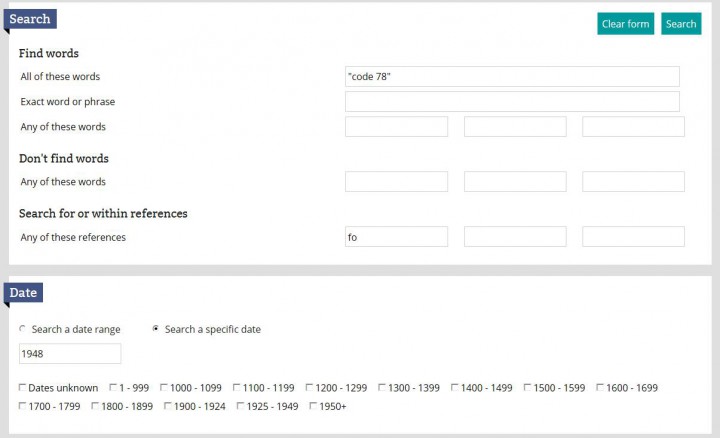
A search for “code 78” in Foreign Office records from 1948 using the advanced search in The National Archives catalogue
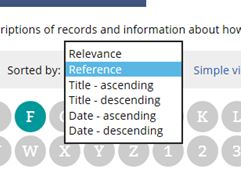
The dropdown list on catalogue search results pages that alllows you to sort results by reference
Step 4: Identify the relevant National Archives reference
Use the dropdown list to sort your search results by reference – this will present results in file and paper number order, allowing you to easily find the FO reference covering the paper and file number from your index entry.
You can now order and view the correspondence.
4.2 Country codes with more than two digits (category codes)
Country codes generally have two digits, but extra numbers were sometimes added to indicate which category the papers were placed in. If your country code has three digits, please refer to the table below:
| Country/category code | Years | FO series | Type |
| xx (no prefix) | From 1920 | FO 371 | Political |
| 1xx | 1920-1939 | FO 395 | News |
| 2xx | From 1920 | FO 369 | Consular |
| 3xx | From 1920 | FO 372 | Treaty |
| 4xx (below 450) | From 1945 | FO 370 | Library |
| 4xx | From 1944 | FO 924 | Foreign Research |
| 4xx (above 450) | From 1945 | FO 924 | Cultural Relations |
| 5xx | 1930-1943 | FO 366 | Chief Clerk / Establishment and Finance |
| 6xx | From 1927 | FO 850 | Communications |
| 7xx | 1929-1933 | FO 627 | Dominions Information |
| 9xx | From 1945 | FO 953 | Information policy |
5. Finding correspondence from 1954-1958 and from 1960 onwards
5.1 Correspondence from 1954-1958 and 1960-1966
The National Archives does not have any registers or indexes for these years.
To find correspondence from these years you should search our catalogue by keyword using the advanced search:
- the keyword would typically be a country or sometimes a person
- ensure FO is inserted into the “Search within references” box
- remember to include the year or year range in the “Date” section
5.2 Correspondence after 1966
In 1967, the registries of the Commonwealth Office and the Foreign Office were merged, more than one year before they themselves were combined as the Foreign and Commonwealth Office. From this point, the records are arranged in regional geographical groups or subject groups reflecting their departmental organisation.
Click on the series codes below to search within those series by keyword and year.
The geographical general correspondence series are:
| Region | Series |
|---|---|
| Europe | FCO 9 (Southern Europe), FCO 28 (Eastern Europe and USSR), FCO 33 (Western Europe), FCO 87 (Republic of Ireland from 1972) |
| The Americas and Atlantic | FCO 7 (America and Latin America), FCO 42 (Gibraltar and South Atlantic to 1971), FCO 44 (West Indies to 1972, West Indies and Atlantic from 1972), FCO 63 (North America and Caribbean to 1969, Caribbean from 1969), FCO 82 (North America from 1971), FCO 83 (Atlantic and Indian Ocean 1971-72), FCO 86 (Gibraltar from 1972), FCO 99 (Mexico and Caribbean from 1977) |
| Africa | FCO 29 (Central Africa 1968-69), FCO 31 (East Africa), FCO 36 (Rhodesia), FCO 39 (North Africa to 1972, Near East and North Africa 1972 only), FCO 45 (Southern Africa to 1969, Central and Southern Africa from 1969), FCO 65 (West Africa), FCO 93 (Near East and North Africa from 1972) |
| Middle East | FCO 8 (Arabia to 1972, Middle East from 1972), FCO 17 (Near East to 1972, Near East and North Africa 1972-73), FCO 39 (Near East and North Africa 1972 only), FCO 93 (Near East and North Africa from 1972) |
| South Asia and Indian Ocean | FCO 32 (Pacific and Indian Ocean to 1971), FCO 37 (South Asia), FCO 40 (Hong Kong and Indian Ocean from 1972), FCO 83 (Atlantic and Indian Ocean 1971-72) |
| Far East, South East Asia and Pacific | FCO 15 (South East Asia), FCO 21 (Far East), FCO 24 (South West Pacific), FCO 32 (Pacific and Indian Ocean to 1971, Pacific Dependent Territories from 1972), FCO 40 (Hong Kong to 1972, Hong Kong and Indian Ocean from 1972) |
The subject general correspondence series are in:
| Subjects | Series |
|---|---|
| Economic, Transport and Communications Departments | FCO 14, FCO 30, FCO 35, FCO 59, FCO 67, FCO 69-71, FCO 74, FCO 76, FCO 96, FCO 98 |
| Defence and Disarmament Departments | FCO 10, FCO 16, FCO 41, FCO 46, FCO 66 |
| Cultural, Development and Scientific Departments | FCO 13, FCO 34, FCO 48, FCO 55 |
| Consular, Migration, Treaty, Protocol and Claims Departments | FCO 47, FCO 50, FCO 53, FCO 57, FCO 64 |
| United Nations | FCO 61 |
| Administrative, Information, Research and Central Policy Departments | FCO 12, FCO 26, FCO 49, FCO 51-2, FCO 56, FCO 68, FCO 72, FCO 86, FCO 95 |
| 1977 Conferences (EEC, NATO, Commonwealth) | FCO 104 |
6. Further reading
Some or all of the publications below may be available to buy from The National Archives’ bookshop. Alternatively, search The National Archives’ library catalogue to see what is available to consult at Kew.
Published copies of records:
- British Documents on the Origins of the War, Documents on British Foreign Policy, Documents on British Policy Overseas (13, 68 and 18 Volumes respectively, HMSO and Routledge, 1926 onwards). Selections of documents (mostly general correspondence) covering the build up to the First and Second World Wars and the Cold War respectively
- British Documents on Foreign Affairs (over 200 volumes, University Publications of America, 1983 onwards). Selection of Confidential Prints from mid-19th to mid-20th century
- British and Foreign State Papers (168 Volumes, HMSO 19th century to 1977). Published copies of major treaties from 1812 to 1967
- Adam Matthew Digital offers various packages relating to foreign issues
- Secret Files from World Wars to Cold War (Intelligence and Foreign Policy files 1873-1953)
Secondary material:
- James Cronan and Keith Mitchell (eds.), Foreign Office Records, 1782 to 1986, An index to country series (Lists and Index Society, 2017)
- FCO Historians, A guide to researching FCO history (Foreign and Commonwealth Office)
- Michael Roper, The Records of the Foreign Office, 1782-1968 (Public Record Office, 2002)
- Louise Atherton, Never Complain, Never Explain: Records of the Foreign Office and the State Paper Office 1500-c.1960 (Public Record Office, 1994), includes well-explained guidance on how to use the registers and indexes to Foreign Office correspondence